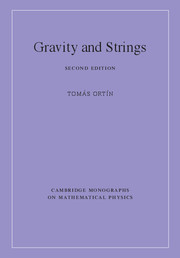Book contents
- Frontmatter
- Dedication
- Contents
- Preface to the second edition
- Preface to the first edition
- Part I Introduction to gravity and supergravity
- Part II Gravitating Point-Particles
- 11 The Schwarzschild Black Hole
- 12 The Reissner–Nordström black hole
- 13 The Taub–NUT solution
- 14 Gravitational pp-waves
- 15 The Kaluza–Klein black hole
- 16 Dilaton and dilaton/axion black holes
- 17 Unbroken supersymmetry I: supersymmetric vacua
- 18 Unbroken supersymmetry II: partially supersymmetric solutions
- 19 Supersymmetric black holes from supergravity
- Part III Gravitating extended objects of string theory
- Appendix A Lie groups, symmetric spaces, and Yang–Mills fields
- Appendix B The irreducible, non-symmetric Riemannian spaces of special holonomy
- Appendix C Miscellanea on the symplectic group
- Appendix D Gamma matrices and spinors
- Appendix E Kähler geometry
- Appendix F Special Kähler geometry
- Appendix G Quaternionic-Kähler geometry
- Appendix H Real special geometry
- Appendix I The generic scalar manifolds of N ≥ 2, d = 4 SUEGRAs
- Appendix J Gauging isometries of non-linear σ-models
- Appendix K n-spheres
- Appendix L Palatini's identity
- Appendix M Conformal rescalings
- Appendix N Connections and curvature components
- Appendix O The harmonic operator on ℝ3 × S1
- References
- Index
19 - Supersymmetric black holes from supergravity
from Part II - Gravitating Point-Particles
Published online by Cambridge University Press: 05 April 2015
- Frontmatter
- Dedication
- Contents
- Preface to the second edition
- Preface to the first edition
- Part I Introduction to gravity and supergravity
- Part II Gravitating Point-Particles
- 11 The Schwarzschild Black Hole
- 12 The Reissner–Nordström black hole
- 13 The Taub–NUT solution
- 14 Gravitational pp-waves
- 15 The Kaluza–Klein black hole
- 16 Dilaton and dilaton/axion black holes
- 17 Unbroken supersymmetry I: supersymmetric vacua
- 18 Unbroken supersymmetry II: partially supersymmetric solutions
- 19 Supersymmetric black holes from supergravity
- Part III Gravitating extended objects of string theory
- Appendix A Lie groups, symmetric spaces, and Yang–Mills fields
- Appendix B The irreducible, non-symmetric Riemannian spaces of special holonomy
- Appendix C Miscellanea on the symplectic group
- Appendix D Gamma matrices and spinors
- Appendix E Kähler geometry
- Appendix F Special Kähler geometry
- Appendix G Quaternionic-Kähler geometry
- Appendix H Real special geometry
- Appendix I The generic scalar manifolds of N ≥ 2, d = 4 SUEGRAs
- Appendix J Gauging isometries of non-linear σ-models
- Appendix K n-spheres
- Appendix L Palatini's identity
- Appendix M Conformal rescalings
- Appendix N Connections and curvature components
- Appendix O The harmonic operator on ℝ3 × S1
- References
- Index
Summary
The construction of classical solutions of GR, with or without matter, is always a difficult task. In the preceding chapters we have constructed and studied the (static) black-hole solutions of some simple theories by using educated ansatz for the symmetries and general form of the metric, solution-generating transformations and other strategies, but the complexity of the solutions of the axion–dilaton model (Section 16.2) and the effort necessary to find them suggests that we must use more powerful methods or restrict ourselves to simpler kinds of solutions if we want to do the same for more complicated theories.
A combination of these two possibilities arises for the supersymmetric solutions of supergravity theories. Considering only supergravity theories is, by itself, a restriction, albeit not a very strong one, in view of the large number of possible models. Their supersymmetric solutions are usually the simplest in their class but they still have interesting physics. In any case they can be used as a first approximation to more complicated and realistic solutions and, sometimes, the latter can be obtained as deformations of the former. While the results obtained using supersymmetric solutions as tractable, solvable, toy models should not be extrapolated lightly to the non-supersymmetric ones, it is clear that there is a great deal to be learned from them. For instance, it is in this class of solutions that the attractor mechanism that holds for all extremal (not necessarily supersymmetric) blackhole solutions was first discovered [531, 1157, 526, 527].
In Chapter 18 we studied a method that allows the complete characterization of those solutions to the point that, in many interesting cases, a recipe can be given to construct them all. These solutions include, depending on the choices of symmetries, functions, and integration constants, cosmic strings, pp waves and other interesting solutions, plus many other less interesting and typically singular solutions of difficult interpretation.
- Type
- Chapter
- Information
- Gravity and Strings , pp. 562 - 604Publisher: Cambridge University PressPrint publication year: 2015



